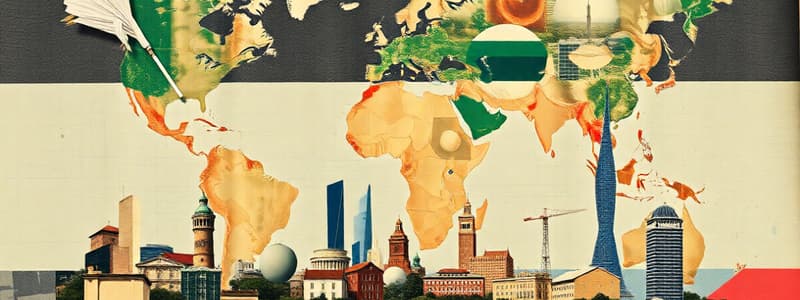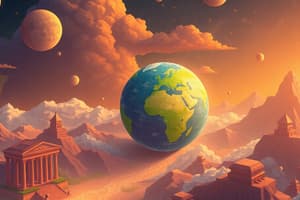Podcast
Questions and Answers
What is the main function of the World Trade Organization?
What is the main function of the World Trade Organization?
- Promote fair trade practices among developing countries
- Regulate international trade and settle disputes between member nations (correct)
- Facilitate investments in transnational corporations
- Oversee national agricultural policies
Which criticism is commonly associated with NAFTA?
Which criticism is commonly associated with NAFTA?
- It has improved agricultural practices in Canada.
- It has shifted labor jobs from Canada and the US to Mexico. (correct)
- It has focused on reducing tariffs for luxury goods.
- It has led to less trade between the US and Mexico.
What are transnational corporations criticized for?
What are transnational corporations criticized for?
- Promoting local labor over global labor
- Contributing equally to local economies
- Operating only in their home countries
- Exploiting vulnerable populations and causing environmental damage (correct)
What does free trade primarily involve?
What does free trade primarily involve?
What is a primary goal of fair trade initiatives?
What is a primary goal of fair trade initiatives?
How do critics view the provisions of free trade?
How do critics view the provisions of free trade?
What is one of the major criticisms surrounding the World Trade Organization?
What is one of the major criticisms surrounding the World Trade Organization?
What is a common misunderstanding about fair trade products?
What is a common misunderstanding about fair trade products?
Which statement about transnational corporations is accurate?
Which statement about transnational corporations is accurate?
What is a significant impact of NAFTA on Mexico's agriculture?
What is a significant impact of NAFTA on Mexico's agriculture?
What was a key factor in promoting economic globalization?
What was a key factor in promoting economic globalization?
Which economic system is characterized by government controlling all aspects of production?
Which economic system is characterized by government controlling all aspects of production?
What was one of the major consequences of the Stock Market Crash of 1929?
What was one of the major consequences of the Stock Market Crash of 1929?
Which of the following accurately describes Keynes’ economic approach?
Which of the following accurately describes Keynes’ economic approach?
What critical role did the Marshall Plan serve post-WWII?
What critical role did the Marshall Plan serve post-WWII?
How did the International Monetary Fund (IMF) primarily seek to promote global economic stability?
How did the International Monetary Fund (IMF) primarily seek to promote global economic stability?
Why was the World Bank often criticized?
Why was the World Bank often criticized?
What represents the area of earth's surface required to sustain resources and waste, known as ecological footprint?
What represents the area of earth's surface required to sustain resources and waste, known as ecological footprint?
In what way did Jamaica's experience with IMF loans in the 1970s negatively impact its domestic industries?
In what way did Jamaica's experience with IMF loans in the 1970s negatively impact its domestic industries?
What key concept is embodied by sustainable development?
What key concept is embodied by sustainable development?
Flashcards
Economic Globalization
Economic Globalization
The process of expanding trade, transportation, and communication systems across the globe, leading to increased global commerce.
Sustainable Prosperity
Sustainable Prosperity
The idea that economic prosperity should be sustainable for the long term without depleting the Earth's resources for future generations.
Centrally Planned Economy
Centrally Planned Economy
An economic system where the government controls all aspects of production and distribution, aiming for equal distribution of wealth.
Roaring 20s
Roaring 20s
Signup and view all the flashcards
Great Depression
Great Depression
Signup and view all the flashcards
Keynesian Economics
Keynesian Economics
Signup and view all the flashcards
Hayek/Friedman Economics
Hayek/Friedman Economics
Signup and view all the flashcards
Cold War
Cold War
Signup and view all the flashcards
World Bank
World Bank
Signup and view all the flashcards
International Monetary Fund (IMF)
International Monetary Fund (IMF)
Signup and view all the flashcards
What is the World Trade Organization (WTO)?
What is the World Trade Organization (WTO)?
Signup and view all the flashcards
What is Free Trade?
What is Free Trade?
Signup and view all the flashcards
What is NAFTA?
What is NAFTA?
Signup and view all the flashcards
What is Fair Trade?
What is Fair Trade?
Signup and view all the flashcards
What are Transnational Corporations?
What are Transnational Corporations?
Signup and view all the flashcards
What is a criticism of the WTO?
What is a criticism of the WTO?
Signup and view all the flashcards
What is a criticism of NAFTA?
What is a criticism of NAFTA?
Signup and view all the flashcards
What is a criticism of NAFTA?
What is a criticism of NAFTA?
Signup and view all the flashcards
What is a criticism of Free Trade?
What is a criticism of Free Trade?
Signup and view all the flashcards
What is a criticism of Fair Trade?
What is a criticism of Fair Trade?
Signup and view all the flashcards
Study Notes
Economic Globalization
- Globalization spreads trade, transportation, and communication systems.
- It promotes worldwide commerce.
- Contributors include:
- Transnational businesses (operating in multiple countries, often outsourcing).
- Containerization (revolutionizing goods transportation).
- The Internet (transforming global communication).
Sustainable Prosperity
- A key question is how to achieve global prosperity without harming the planet.
- Sustainable development focuses on growth that doesn't deplete resources for future generations.
Economic History - Post WWI
- WWI disrupted global and domestic economies.
- Infrastructure was destroyed.
- Some countries (e.g., US, Canada) did well post-war.
- Others (e.g., Germany, Austria) faced high inflation and severe poverty post-war.
Economic History - Economic Systems
- Russia's poverty led to a push for communism.
- Joseph Stalin established a centrally planned system.
- The government controlled production and distribution.
- An aim to provide wealth equally.
- The Soviet Union became an economic and industrial powerhouse.
Economic History - The Roaring 20s
- A period of rebuilding after WWI, marked by:
- Optimism.
- Economic prosperity.
- High investments.
- Market-based economies (e.g., US, Canada) based on supply and demand rather than central planning.
Economic History - Stock Market Crash and Great Depression
- Stocks rapidly rose and then suddenly fell.
- Many investors lost their savings due to the stock market crash.
- The economic downturn (Great Depression) led to:
- Bank failures.
- Reduced international trade.
- High unemployment and poverty.
Economic History - Keynes VS Hayek and Friedman
- Keynes supported government intervention in the economy (e.g., spending on public works).
- Hayek and Friedman argued against extensive government intervention, preferring a market-based system.
Economic History - Cold War
- Post-WWII, the US initiated the Marshall Plan to rebuild Europe.
- The plan aimed to turn Europe into a strong trading partner.
- A powerful USSR sought to expand influence, leading to:
- Ideological conflict.
- Economic competition between market and communist systems.
- The Cold War.
Bretton Woods: World Bank and IMF
- International conference established the World Bank and the IMF near the end of WWII.
- Its policy was to achieve international monetary stability after the Great Depression.
World Bank
- The World Bank provides long-term loans to developing countries.
- Countries receiving loans must adhere to specific rules (e.g., reduced government spending on social programs).
- Focus on reducing corruption and competition in developing markets.
International Monetary Fund (IMF)
- The IMF is funded by member countries.
- It aims to boost global trade and free markets.
- Promotes stability in major currencies, providing short-term loans to countries with balance of payment issues.
Criticisms of the World Bank and IMF
- The World Bank is sometimes seen as an extension of US policy, with loan conditions seen as too harsh in some cases.
- Conditions imposed on developing countries sometimes have unintended social consequences.
- The IMF is criticized for prioritizing economic issues over labor, environmental protection, and the wellbeing of citizens.
Sustainable Development
- Sustainable development involves economic growth that doesn't deplete resources for future generations.
- Conserving resources and fostering stewardship are integral to this concept.
- Rapid economic growth often leads to unsustainable practices.
Ecological Footprints
- An ecological footprint measures the area of Earth's surface needed to support a person's consumption patterns.
- This includes the resources used and waste produced.
Climate Change – Causes
- Human activity has dramatically changed the global climate
- The burning of fossil fuels increased CO2. levels.
- This significantly accelerates natural warming processes.
Climate Change – Evidence
- Evidence of climate change includes sea level rise, rising global temperatures, shrinking ice sheets, and increasingly extreme weather.
Case Studies – Life and Debt
- Jamaica took an IMF loan in the 1970s, leading to cuts in social programs.
- The country's economy was further affected by free trade policies, potentially harming local industries.
Case Study – WTO
- The World Trade Organization (WTO) is an intergovernmental organization regulating international trade.
- It provides a platform for negotiations and dispute resolution.
- Criticisms include its bias towards wealthy nations and its neglect of labor and environmental concerns.
Case Study – NAFTA
- The North American Free Trade Agreement (NAFTA) fostered free trade among Canada, the US, and Mexico.
- Critics point to the potential for job losses in Canada and the US, and agriculture industry damage in Mexico.
Case Study – Transnational Corporations
- Transnational corporations (TNCs) operate across multiple countries.
- They access foreign markets and obtain cheap labor/resources.
- Criticisms include their significant economic power, control of energy resources, exploitation of vulnerable populations, and negative environmental consequences.
Case Study – Free Trade
- Free trade aims to reduce trade barriers (e.g., tariffs) between countries.
- It promotes unrestricted access to markets.
- Critics argue that existing regulations and rules may give unfair advantages to larger nations.
Case Study - Fair Trade
- Fair trade focuses on sustainable development and alleviates poverty by sending more money to producers and investing in their communities.
- It promotes fairer prices and better working conditions.
- It can be more expensive than conventional products, and its success depends on how it is implemented.
Studying That Suits You
Use AI to generate personalized quizzes and flashcards to suit your learning preferences.




